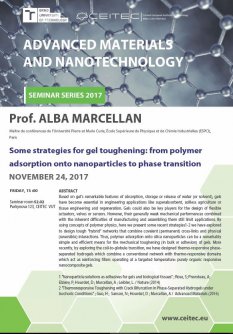ABSTRACT
Based on gel's remarkable features of absorption, storage or release of water (or solvent), gels have become essential in engineering applications like superabsorbent, soilless agriculture or tissue engineering and regeneration. Gels could also be key players for the design of flexible actuators, valves or sensors. However, their generally weak mechanical performances combined with the inherent difficulties of manufacturing and assembling them still limit applications. By using concepts of polymer physics, here we present some recent strategies1-2 we have explored to design tough “hybrid” networks that combine covalent (permanent) cross-links and physical (reversible) interactions. Thus, polymer adsorption onto silica nanoparticles can be a remarkably simple and efficient means for the mechanical toughening (in bulk or adhesion) of gels. More recently, by exploring the coil-to-globule transition, we have designed thermo-responsive phase-separated hydrogels which combine a conventional network with thermo-responsive domains which act as reinforcing fillers operating at a targeted temperature: purely organic responsive nanocomposite gels.
1 "Nanoparticle solutions as adhesives for gels and biological tissues" ; Rose, S; Prevoteau, A; Elziere, P; Hourdet, D ; Marcellan, A ; Leibler, L. / Nature (2014)
2 "Thermoresponsive Toughening with Crack Bifurcation in Phase-Separated Hydrogels under Isochoric Conditions" ; Guo, H ; Sanson, N ; Hourdet, D ; Marcellan, A / Advanced Materials (2016)
SHORT CV
Associate Professor at Université Pierre et Marie Curie (UPMC)
Laboratory of Sciences et Ingénierie de la Matière Molle (SIMM), UPMC – CNRS UMR 7615, École Supérieure de Physique et de Chimie Industrielles (ESPCI), 10 rue Vauquelin, 75005 Paris
Career and References dates
After my PhD in Mechanics and Materials at the École des Mines in Paris, I began working in a Polymer Chemistry and Soft Matter research environment at ESPCI. My research activities are mainly focused on the design and the understanding of the reinforcement mechanisms in polymer "model" systems, essentially polymer fibres and gels.
By using the concepts of polymer physics, with my colleagues, I have developed a new method for glueing gels and biological tissues. Beyond the promising results for surgery, this concept opens up a new paradigm for adhesion: glueing without polymers but using solid nanoparticles. Since 2016, I am invited as an associate professor at the Global Station for Soft Matter (GSS). Serving as an international research hub, GSS is expected to provide an innovative platform of soft matter research and education.
Prizes / Fellowships
- 2017 Fellowship of the Institut Universitaire de France (5 years)
- 2016 Fellowship of the Global Station for Soft Matter, international hub for research and education (5 years)
- 2014 Award of the Groupe Français des Polymères/ Société Française de Physique, Société Chimique de France. This prize rewards every two years a young researcher (<40 years) for his/her contribution in Polymer Science.
Recent major publications – Graphical abstract
- "Multiaxial mechanical behavior of aramid fibers and identification of skin/core structure from single fiber transverse compression testing"; Wollbrett-Blitz, J ; Joannès, S ; Bruant, R ; Le Clerc, Ch ; Romero De La Osa, M ; Bunsell, A ; Marcellan*, A / Journal of Polymer Science Part B-Polymer Physics (2016)
- "Nanoparticle solutions as adhesives for gels and biological tissues" ; Rose, S; Prevoteau, A; Elziere, P; Hourdet, D ; Marcellan*, A ; Leibler*, L. / Nature (2014) – News and Views – From Altmetric: in the 98 percentile of the most cited articles of similar age
-
"Thermoresponsive Toughening with Crack Bifurcation in Phase-Separated Hydrogels under Isochoric Conditions" ; Guo, H ; Sanson, N ; Hourdet, D ; Marcellan*, A / Advanced Materials (2016)








